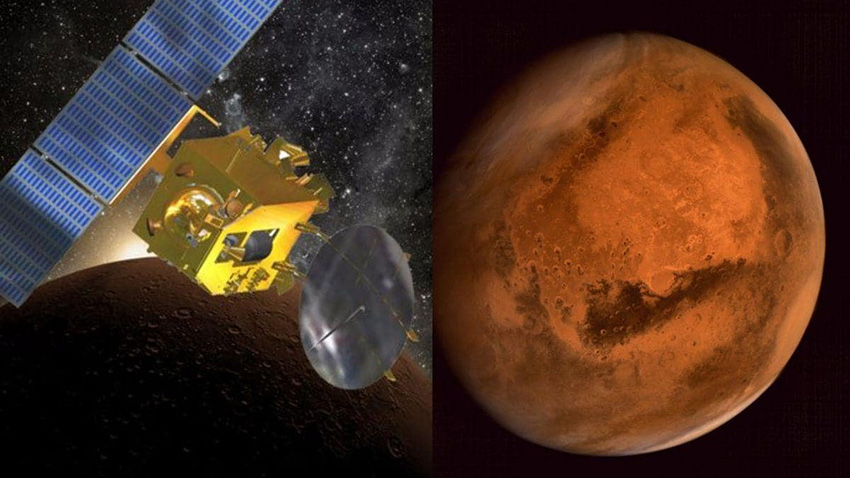ISRO-MOM 2: ISRO Begins Preparations for Second Mars Mission
By R. Anil Kumar
Synopsis
-
As the Indian Space Research Organisation prepares for its second mission to Mars, the world eagerly anticipates another chapter in India’s remarkable space exploration journey.
-
Mangalyaan-2: ISRO working on the second mission to Mars nine years after MOM’s success
-
Mangalyaan-2 mission: will carry four payloads to inspect certain characteristics of the Mars including its atmosphere, environment and the interplanetary dust.
Bangalore, October 2. The Indian Space Research Organisation (ISRO), on a high with the success of Chandrayaan-3, has its eyes set for multiple future missions. It is now seeking to repeat the Mars mission’s success by sending another spacecraft to the red planet. Mangalyaan was one of India’s most savoured successes in space exploration and had made India’s space programme a force to be reckoned with.

Indian space enthusiasts have reason to celebrate as the Indian Space Agency, ISRO embarks on its second mission to the red planet, Mars, nine years after its historic debut.
This upcoming mission, informally known as Mangalyaan-2, will be equipped with four specialized payloads aimed at conducting in-depth studies of various aspects of Mars, including interplanetary dust, the Martian atmosphere, and the surrounding environment.
While specific details about the payloads remain undisclosed, an official source within ISRO mentioned that these instruments are currently in various stages of development. This secrecy surrounding the payloads adds an element of intrigue to the mission.
The historic significance of India’s Mars missions cannot be overstated. Nine years ago, on September 24, India achieved a remarkable feat by successfully entering Mars’ orbit on its very first attempt—a milestone that no other space agency had accomplished at the time.
Mangalyaan-2’s payload includes the Mars Orbit Dust Experiment (MODEX), a Radio Occultation (RO) experiment, an Energetic Ion Spectrometer (EIS), and a Langmuir Probe and Electric Field Experiment (LPEX).
Each instrument serves a unique purpose in unraveling the mysteries of Mars.
MODEX will play a crucial role in understanding the origin, distribution, and flux of interplanetary dust particles (IDPs) at high altitudes on Mars. It will detect particles ranging from a few hundred nanometers to a few micrometers, helping to explain the dust dynamics around Mars.
The RO experiment, operating at X-band frequency, will measure neutral and electron density profiles, shedding light on the behaviour of the Martian atmosphere.
EIS, designed to characterize solar energy particles and solar wind particles in the Martian environment, will aid scientists in comprehending the factors contributing to the loss of Mars’ atmosphere.
Lastly, LPEX will provide valuable data on electron number density, electron temperature, and electric field waves, enhancing our understanding of the plasma environment on Mars.
The first Mars orbiter mission, launched on November 5, 2013, was India’s inaugural interplanetary venture. It exceeded expectations by not only entering Mars’ orbit but also extending its operational life to seven years, far beyond its initial six-month design.
The primary objectives of the initial mission were to demonstrate India’s capabilities in designing, launching, and operating a Mars orbiter spacecraft with a high degree of autonomy.
It was a testament to India’s technological prowess and its ability to excel in the field of space exploration.
As the Indian Space Research Organisation prepares for its second mission to Mars, the world eagerly anticipates another chapter in India’s remarkable space exploration journey.
Mangalyaan-2 promises to add more valuable insights to our understanding of the red planet and cement India’s position as a leading player in interplanetary exploration.
Nine years after Mangalyaan’s success of placing a rocket on the Mars orbit, ISRO is working on the Mars Orbiter Mission-2 aka Mangalyaan-2, to carry four payloads to inspect certain characteristics of the Mars including its atmosphere, environment and the interplanetary dust.
The MODEX will help understand the origin, abundance, distribution and flux at high altitudes of Mars, while the RO experiment will measure neutral and electron density profiles. The EIS under development would help in characterising solar energy particles and supra-thermal solar wind particles of the Mars environment. Last but not the least, the LPEX will help in measuring the electron number density, electron temperature and electric field waves that will shed some light on the plasma environment on Mars.
Mangalyaan or Mars Orbiter Mission was launched by ISRO on November 5, 2013, and entered Mars orbit successfully on September 24, 2014. With that India became the fourth country to place a spacecraft on Mars orbit, and the first country to do so in the first attempt. It must be mentioned here that the Mars mission was realised only at Rs 450 crore.
It carried five payloads for a “primarily technological” mission. It carried a Mars Color Camera (MCC), Thermal Infrared Imaging Spectrometer (TIS), Methane Sensor for Mars (MSM), Mars Exospheric Neutral Composition Analyser (MENCA), and Lyman Alpha Photometer (LAP).
Mangalyaan produced over thousands of images through the MCC, and ISRO published more than 35 research papers in peer-reviewed journals, apart from the key technical and scientific achievements.





